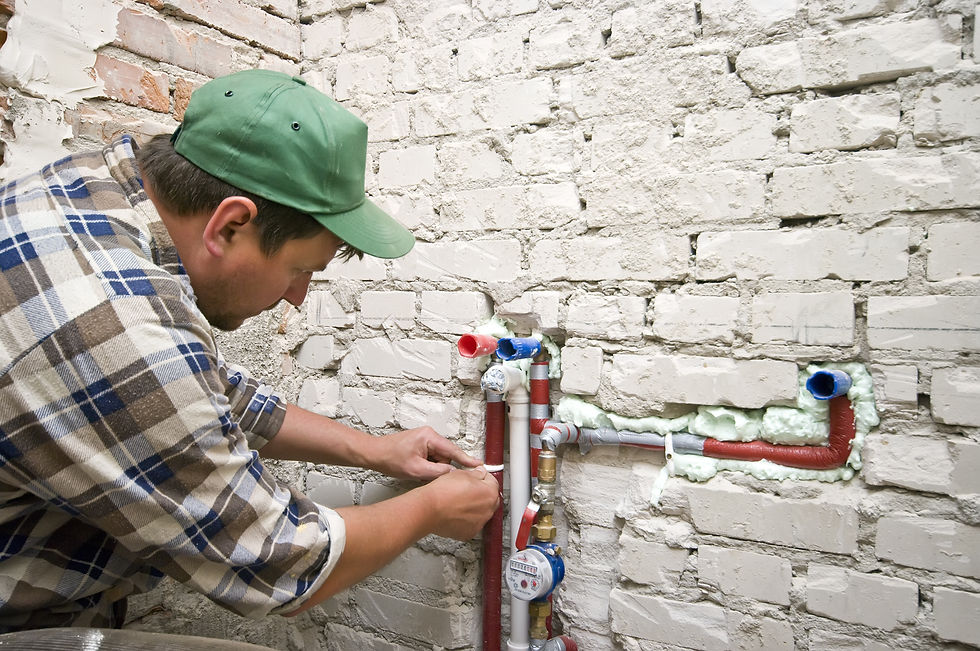Evolution of Plumbing System & Introduction to Plumbing System
- SkillCat Team
- Apr 8
- 7 min read
Introduction to Plumbing: Chapter 1
Evolution of Plumbing system
In this module, we will go through the history of plumbing systems. We’ll also discuss how it has changed over the years. Skip to quiz!
History of Plumbing | First Indoor Plumbing
Plumbing has played a significant part in how civilizations have evolved. The earliest plumbing pipes were made of baked clay and straw. The Egyptians made the first copper pipes.
Public baths were first established in ancient Rome, Greece, Persia, India, and China. The baths were used for both hygiene and socialization.

For centuries, the most advanced plumbing included Rome's lead water pipes and aqueduct system. They were made from a series of pipes, tunnels, canals, and bridges. Aqueducts were dependent on gravity and the land's natural slope to carry water from a freshwater source.
For potable water, galvanized iron piping was commonplace in the United States from the late 1800s until around 1960. After that period, copper piping took over.
World War II restricted iron, steel, and copper due to a material shortage. This forced the plumbing industry to start using new materials like plastics.
Water conservation laws were introduced in 1978. Californians were prohibited to use more than 3.5 gallons of water per flush. Low-flow toilets were created to conserve water in 1992.
As time passed, efforts were made to standardize regulations of plumbing systems in the United States. The first plumbing code was published in 1928.
Shortfalls of Traditional Systems
Before modern technology played a role in plumbing, the traditional solutions were unwieldy and required a lot of effort to maintain. Repairing pipes was time-consuming and very labor-intensive.

The repair work required businesses to either vacate the premises or live without running water. Due to the expenses and time involved, this would often lead to losing homes or businesses.
Today the standard usage of water has increased. In the past, a family got by with only 50 liters of water. By today's standards, a family now uses at least 135 liters of water.
Traditional plumbing systems could not handle huge water demands. That’s why most modern water supply pipes are made out of steel, copper, and plastic.
One of the greatest dangers of traditional plumbing systems is cross-contamination. This occurs when pipes carrying wastewater and clean water connect. This usually happens when wastewater backs up in a building’s pipes. This issue could result in severe problems and health risks.
Modern Plumbing Systems
Any home built before the 1990s could potentially have pipes made from materials that are no longer approved by U.S. building codes. For example, lead is not used in plumbing because it is highly toxic.

Modern plumbing helps to ensure the physical separation between waste and clean water pipes. Modern plumbing avoids cross connections to prevent cross-contamination. This keeps the water in our homes clean and safe at all times.
Plumbing valves allow us to control and direct water for its use. Modern plumbing systems also prevent water wastage.
Until the 1800s, there were no washrooms and toilets inside homes. People had to walk outdoors to take care of their business. Modern plumbing allows us to use washrooms and toilets in the comfort of our own homes.
In addition to comfort, plumbing has allowed us to bring beauty into our lives. Modern plumbing allows us to have high-end bathing systems in our homes. Something that was once a necessity has now become a source of entertainment and relaxation.
The modern plumbing system includes water faucets with sensors for reduced water wastage. Automatic faucets have the advantage of shutting off automatically after hand washing. Their automatic shut-off mechanism reduces the risk of sink overflow because they shut off automatically.
The clean, sanitary conditions provided by modern plumbing have likely protected many lives and extended life expectancy. This is because of the availability of clean drinking water to the general population.
Plumbing has played a significant part in how civilizations have evolved. The use of lead for potable water declined sharply after World War II because of increased awareness of the dangers of lead poisoning.
As time progressed, an effort was made to standardize regulations of plumbing systems in the United States. Modern plumbing systems improve the lives of the people and provide more water efficiency.
Introduction to Plumbing Systems
In this module, we will introduce you to plumbing systems. We’ll also discuss what plumbers do. Skip to quiz!
Plumbing Definition
A plumbing system consists of pipes, valves, and plumbing fixtures such as toilets, sinks, showers, and bathtubs. It also consists of equipment that holds other fluids

We use plumbing systems for the distribution of drinking water. Plumbing systems are also used to supply water to kitchens and bathrooms. We also use them to remove wastewater and rainwater in buildings.
Three phases of plumbing can be divided into:
Underground rough-in,
Aboveground rough-in, and
Finish, also called trim-out or trim finish.
Let’s discuss each of them in detail
A plumber locates all the supply and waste connections from a building system to public utilities during the underground rough-in phase. The plumber establishes where these systems will enter or leave a building.
During the aboveground rough-in phase, a plumber:
Cuts holes in the wall, ceiling, or floor to attach or hang pipes for connection to fixtures.
Installs pipes for a building’s various supply and waste systems.
Uses welding tools and soldering equipment to join pipe runs or special chemicals to join plastic pipes.
Operates power threading machines, propane torches, and other power tools.
In the finishing phase, a plumber installs fixtures such as sinks and showers. A plumber also installs appliances like dishwashers, water purification systems, and water heaters.
Plumber Duties

Plumbers, pipefitters, and steamfitters typically do the following:
Prepare cost estimates for clients.
Read blueprints and follow state and local building codes.
Determine the materials and equipment needed for a job.
Install pipes and fixtures
Inspect and test installed pipe systems and pipelines
Troubleshoot malfunctioning systems
Maintain and repair plumbing systems
A plumber should have the following skills:
Physical Skills,
Interpersonal Skills, and
Safety Skills.
Let’s go over each of them in detail.
Physical skills include the ability to:
Be flexible - Navigate tight spaces to get to the pipe or appliance you are working on
Be strong - Hold one’s arm and head steady when supporting a tool or piece of pipe,
Be nimble - Use one’s fingers to manipulate small objects.
Interpersonal skills that plumbers should have are:
Strong verbal skills,
Good decision-making ability,
Excellent troubleshooting ability, and
Great collaborative skills.
Safety skills are a must for any plumbing job. This is because a plumbing career involves significant risks and hazards, including:
Noise and hearing loss from loud machinery,
Eye injuries, and
Electrical shocks.
A plumbing system consists of pipes, valves, and plumbing fixtures such as toilets, sinks, showers, and bathtubs. The three phases of plumbing are underground rough-in, aboveground rough-in, and finishing.
A plumber should have the following skills:
Physical Skills,
Interpersonal Skills, and
Safety Skills.
You can start your career in plumbing maintenance at Jooble too!
Question #1: How do historic plumbing systems, like aqueducts, work?
They depend on gravity and the land's natural slope to carry water from a source.
They depend on motor-powered pumps.
They depend on duct size.
They depend on valves.
Scroll down for the answer...

Answer: They depend on gravity and the land's natural slope to carry water from a source.
Aqueducts were dependent on gravity and the land's natural slope to carry water from a freshwater source.
Question #2: What is the purpose of plumbing building codes? (select all that apply)
To ensure water is available to everyone
To protect a buildings' inhabitants and ensure the safety of future buyers
To standardize regulations of the plumbing system
To stop air pollution
Scroll down for the answer...

Answer: To protect a buildings' inhabitants and ensure the safety of future buyers
To standardize regulations of the plumbing system
Plumbing building codes were made to standardize regulations of plumbing systems in the United States. They also protect a buildings' inhabitants and ensure the safety of future buyers.
Question #3: What are the shortfalls of a traditional plumbing system? (select all that apply)
Traditional systems use advanced manufacturing techniques
The repair work requires businesses to vacate the premises
Wastewater backs up in pipes
Traditional plumbing is not sustainable for heavy loads
Scroll down for the answer...

Answer: The repair work requires businesses to vacate the premises
Wastewater backs up in pipes
Traditional plumbing is not sustainable for heavy loads
The repair work of a traditional system requires businesses to vacate the premises. The wastewater can back up in a building’s pipes. It is not sustainable for heavy loads.
Question #4: What are the pros of modern plumbing systems? (select all that apply)
Plumbing valves allow us to control and direct water
Plumbing systems reduce air pollution
Modern plumbing allows us to have high-end bathing systems in our homes
Modern plumbing prevents water wastage
Scroll down for the answer...

Answer: Plumbing valves allow us to control and direct water
Modern plumbing allows us to have high-end bathing systems in our homes
Modern plumbing prevents water wastage
Pros of modern plumbing systems are:
Modern plumbing allows us to have high-end bathing systems in our homes
Plumbing valves allow us to control and direct water for its use
Modern plumbing prevents water wastage
Question #5: What are the three phases of plumbing? (select all that apply)
Start plumbing
Underground rough-in
Aboveground rough-in
Finish plumbing
Scroll down for the answer...

Answer: Underground rough-in
Aboveground rough-in
Finish plumbing
Three phases of plumbing can be divided into:
Underground rough-in,
Aboveground rough-in, and
Finish, also called trim-out or trim finish.
Question #6: What do plumbers do in the underground rough-in phase of plumbing?
Make supply and waste water connections
Establish connection between home and city water line
Cut holes in wall
Install fixtures such as sinks and showers
Scroll down for the answer...

Answer: Make supply and waste water connections
During the underground rough-in phase, a plumber locates all the supply and waste connections from a building system to public utilities.
Question #7: What do plumbers do in the finishing phase of plumbing?
Make supply and waste water connections
Establish connection between home and city water line
Cut holes in wall
Install fixtures such as sinks and showers
Scroll down for the answer...

Answer: Install fixtures such as sinks and showers
In the finishing phase, the plumber installs fixtures such as sinks and showers.
Question #8: What skills the plumber should have? (select all that apply)
Physical Skills
Interpersonal Skills
Cooking Skills
Software skills
Scroll down for the answer...

Answer: Physical Skills
Interpersonal Skills
A plumber should have the following skills:
Physical Skills
Interpersonal Skills
Safety Skills
Other References: